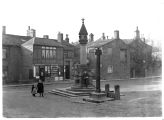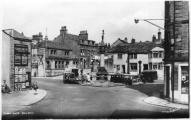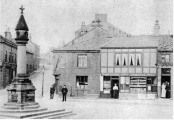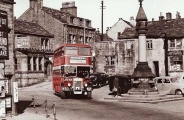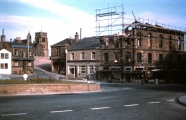Towngate
General
This is the area around the Potted Meat Stick, and the Cross and Stocks that is regarded as the centre of Baildon. Pre 1960s the Potted Meat Stick, Cross and Stocks were to the right of the bottom of Hallcliffe when viewed from Hallcliffe.
One of the dominant buildings in Towngate prior to the rebuilding of the 1960s was Fountain Buildings that housed the Mechanics Institute. Records show that the Mechanics Institute was built in 1862. This is the same year as the Potted Meat Stick, which was a fountain. I assume this is why there were Fountain Buildings and Fountain Fold. The Fountain Buildings were demolished in the late 1960s along with the buildings behind and to the side - Fountain Fold, Manor Croft, Manor Fold, one side of Browgate and parts of Kelcliffe.
During the rebuilding in the late 1960s the Cross and Stocks were moved to the paved area opposite the Liberal Club/Pickles and the Potted Meat Stick taken away only for it to be found and returned in 1986.
In 1853 Towngate got the first gas light of the village, it was mounted on the top of the Market Cross - see more in Market Cross section below.
In the 1960s the roundabout was built. The Potted Meat Stick was removed and the Stocks and Cross moved to the new paved area directly opposite the Liberal Club building. Read more below about The Potted Meat Stick being found in pieces and returned to the village centre in 1986.
Potted Meat Stick
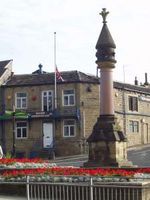
The Potted Meat Stick is a reminder of the Holdens, a leading Baildon family. It was given to Baildon in 1862 by Lord Justice Amphlett of Wychbold Hall, Somerset (Richard Paul Amphlett) (?Baron Amphlett of Somerset) and his wife, Mrs Amphlett, as a memorial to Mrs Amphlett's mother, Frances Ferrand. Frances was the younger daughter of William Holden.[1]
Baildon had the choice of a gift of a carillon of bells for the church, or a drinking fountain for Towngate. A drinking fountain was chosen. For the erection of the fountain to proceed the Local Board pulled up the stocks in Towngate and sent the stone to be used to build the reservoirs on the moors.[2]
There is reference to an agreement for the erection of a fountain in the notes from the minutes of the Baildon Local Board for 18 March 1862
Each side of the base of the fountain bears an inscription.
The inscriptions read:-
This Fountain Was Erected And Presented To
The Inhabitants Of Baildon By Rich : Paul
Amphlett, Esq., And His Wife Frances, In
Memory Of Her Mother, 1862.
To The Memory Of Frances, Widow Of Edward
Ferrand, Esq., Of S. Ives And Daughter Of
William Holden, Esq., Of This Place.
Jesus stood and cried, saying, If any man thirst let
him come unto me and drink.
S.John, 7th 37th.
Worship him that made Heaven and Earth and the
Sea and the Fountains of Waters.
Rev., 14th 7th.
The Bradford Review of Thursday 01 January 1863 printed a very good report of the inauguration of the drinking fountain that took place on 30 December 1862; it is worth reading. A good description of the fountain is given. Towards the end of the report it mentions that Mr. Lofthouse said that nothing had been said as to the good quality of the water he then filled a tumbler with water, and presented it to Mr. Amphlett, which that gentleman drank amid repeating cheering.[3]
Even though the Bradford Review mentions the filling of a tumbler John La Page says there is strong evidence that the fountain never actually worked and the term potted meat stick suggests some derision. Perhaps it was felt that it was given by a foreigner. It can be seen in many Towngate photos that in the 1920s the area became a bus terminus and in 1925 the Council decided the fountain was in the way of the buses. An attempt was made to move it to the left-hand side of the moor road almost opposite the Golf House. However the fountain had become a valued part of the village, so much so that Baildoners objected to the move and by force majeure prevented the contractors from carrying out the work. The fountain became the bus terminus.[2]
Two years later the Shipley Times and Express, of Saturday 08 October 1927, tells of public opinion stopping the Baildon Urban Council moving the Potted Meat Stick to a new location on the edge of Baildon Moor. The contractor turned up and put scaffolding around the fountain as the public were getting themselves galvanised. The report in the 'paper is very detailed and includes details of a letter from the Lord of the Manor Col. Maude. The result - the fountain stayed in Towngate.[4]
The date of the article is two years different to the date mentioned in John La Page's book. Where there two such similar attempts? Doubtful. The images of the Shipley Times and Express clearly show the date and the report mentions that the 'paper's representative was there at the time so it is likely that there was an attempt to move the fountain in October 1927.
The fountain is a weighty structure and any vehicle hitting it would come off worse however the Towngate Stocks are not so mighty and there are several reports of vehicle damage and needy repairs. It is not surprising that the Baildon Urban Council were working on ways to make things safer. It is not clear what Baildon Local Board meant by inconvenient in their meeting of 14 Nov 1862 but even back then it was thought the village centre needed rearranging.
It was not until the 1960s that any major changes were made and this time the fountain was not so lucky. It was removed during the changes to the village centre and ended up in pieces in various Council yards. It was found, restored and put in its present position using money from Mechanics' Institute Funds in 1986.[5] Colin S Michallat says that the late Bernard Stubbs played a part in saving the Potted Meat Stick for Baildon, Colin remembers seeing it firstly in the Council yard off Otley Road, then on a Council tip off Tong Street, then next to the one at Dock Field, only a few feet from it falling into the river. Colin says the late Cllr Fred Atkinson found the money to rebuild it, and that his memorial stone is hidden by the flowers surrounding the fountain.
An excellent video of the reconstruction of the fountain can be seen on YouTube here
Its location can be seen here.
Stocks

It is not known when Baildon got its Stocks but Parliament's "Statute of Labourers"[6] in the 14th century should have meant that every town had Stocks or something similar at that time.[2]
There is some doubt as to who the last person was to be confined in the stocks. John La Page mentions, in his book written in 1951, that an old woman who, back at the time of his writing had died recently, could remember the stocks being used. The man was condemned to sit on the stone base of the cross while in the stocks during November from 10am to 6pm. Baildoners felt sympathetic and John La Page tells of him being offered tea to drink and whisky and, by Raphael Ambler, a hat to sit on, but the local constable was vigilant. John La Page acknowledges that others suggest that the last person to occupy the stocks was Throup Lilley who was guilty of miss-treating a horse.[2] (HMP Wakefield Nominal Register records show that in March 1882 Throup Lilley age 51, a Carter of Otley, was sentenced to 14 days hard labour for being drunk when in charge of a horse and cart. Perhaps he didn't mend his ways after sitting on the cold base of the cross?)
The earliest direct reference to the Towngate Stocks is when the Baildon Local Board, in their meeting of 14 Nov 1862, mention that the stocks are in an inconvenient place.[7]
In 1862 Baildon chose a fountain over a carillon of bells and when the fountain (Potted Meat Stick) was installed the stocks were removed to the reservoirs that were being built on Baildon Moor.[2] A photo was taken at this time showing the Potted Meat Stick, the Stocks, and the Cross.[8] (Where is this photo?) Was it the positioning of the Potted Meat Stick that caused the Local Board to suggest that the Stocks were in an inconvenient place or was there a feeling that by 1862 stocks were no longer a thing to have in the Towngate?
It is a fact that the pillars of the stocks were taken to the site of the reservoirs in 1862 but it seems likely that they were used there in a way that they could be retrieved without too much effort and with no damage to the integrity of the reservoir. Some reports suggest that when they were removed they were broken up and used in the construction of the reservoirs others suggest that historians made notes of their searches and after many hours browsing around "came across" the stocks in the walls of the reservoir. What seems likely is that in 1904 John Wilks could remember what his father had told him and, as a Councillor, was in a position to take people to them once the Council thought something could be done with them.[8] [9]
In 1904 John Wilks, who had a pretty good idea where the pillars for the stocks were, went up to the reservoir with William Scruton, George E Robinson (chairman of the District Council) and a couple of other people. The location of the pillars was confirmed and soon after they were put back next to the Cross, positioned so that someone confined in them could still sit on the stones at the base of the cross.[10] [11]
Over the years Towngate got more and more busy with horse drawn carts and later with parked cars and 'buses that used the area as their terminus and turning circle. The stocks were damaged on several occasions, one time by a runaway horse (brewer's dray?) in 1923,[12]) another time, in 1929, by a reversing vehicle, and the pillars repaired or replaced such that it is now unlikely that anything remains of the original stocks.[13] Arthur Edwick, in his handwritten notes mentions that the nearby Towngate Cross was also damaged and its top replaced.
Various ideas of how to improve the traffic situation in Towngate were talked about and then in the 1960s, as part of a major redevelopment, the stocks and Market Cross were moved to a new paved area in Towngate that was surrounded by low walls so it is unlikely that they will be damaged by vehicles again. The Potted Meat Stick was also moved - to a Council yard.
Looking through photos of Towngate that show the stocks it can be seen that sometimes there was no upper piece of timber to the Stocks and at other times photos show a piece missing from one of the pillars and what looks like a repair through the whole section. Yet other photos show that the pillar that appears damaged in some looks new in others, suggesting that it was replaced.
-
Stocks with no upper timber
-
Damaged pillar. 1923?
-
Replaced pillar. Damaged Cross. 1928
-
All new Stocks report
Market Cross
In the Baildon Local Board meeting of 15 October 1853 the minutes record that Mr Butler of Kirkstall Forge was given permission to install the first gas lamp in the village. This was fixed on top of the old Market Cross in the Village square, and there is a minute recorded - “that Shipley Gas Company be invited to supply new burners at a charge of 29s/- for 1750 hours of supply (4 ft. burners) and 35s/- for 5 ft. burners.
The 1929 Baildon Carnival Programme mentions that the top of the cross was knocked off by a removal van in the previous year and a new block was atop the shaft. "This rather spoils the appearance of the Cross, for it can be seen that it has not been repaired in keeping with its history."[14]
Notes from A Edwick mention that the stone pillar which stands adjacent to the Stocks was badly damaged by a motor driven vehicle and the original “top” was broken off. This damage was done by a driver employed by Briggs of Harden who supplied paraffin to Noble’s Hardware Shop in the village centre. A new stone top was put on later. This information was supplied to A Edwick by Joe Noble.[15]
Conservative Club

This photo showing Enoch & Sarah Proctor above the cellar steps was taken sometime between 1891 & 1910. The 1891 Census has Enoch & Sarah living at 11 Tentercroft. Enoch was a Cloth Weaver and Sarah a Fish Dealer. In 1901 Enoch (51) & Sarah (56) were still at 11 Tentercroft with Enoch listed as Greengrocer. If it is the same Enoch then records show that he was buried in Baildon 3 Aug 1910 and had been living at the Workhouse, Newall, Otley. (The workhouse later became a hospital and then flats.)
Golden Anniversary Souvenir. 1885-1935
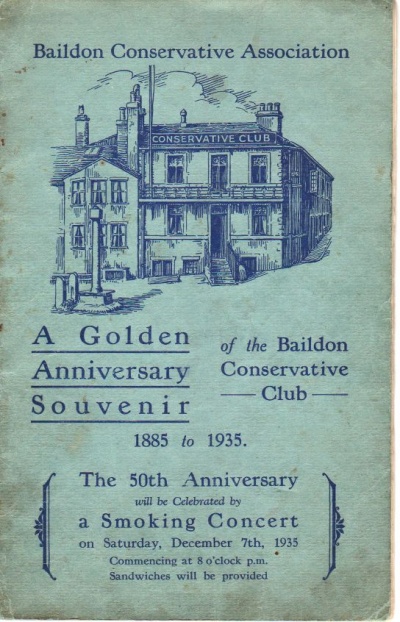
In 1935 a souvenir booklet was produced commemorating 50 years of the Club - 1885 to 1935.Baildon Conservative Club Golden Anniversary. 1935.
Club of the Week
In their Club of the Week spot for Thursday, 31 August 2000 the Target covered Baildon Conservative Club.

Village club looking for business Thursday, August 31, 2000 Baildon Conservative Club has been a central part of the village for more than 100 years. It has always been in the same spot overlooking the Potted Meat Stick monument and has witnessed many changes going on around it as well as changing itself to move with the times and demand. Years ago it was the snooker tables in the middle of the floor which were the focal point of the club - recently an extension was built on and the tables were moved to make more space. There are two snooker tables as well as a pool one and there’s always a game of dominoes on offer. For those who prefer to watch sport rather than to play it, the club has just bought a wide screen television. Every Saturday there’s a quiz and on alternate Saturday nights it’s followed by stage acts. Club member Eddy Robinson said: “We have all sorts of entertainment lined up - from charity nights to Play Your Cards Right, Millionaire — even Somerset Pig Racing!” And he added: “We've got more than 550 members, but they don’t all come and use the club. “We've got fantastic facilities here so I can’t understand why people don’t all come and make the most of it.” The club is looking at getting its rooms booked up during the day for private parties and important occasions such as wedding receptions and even funeral teas. It also hoping that businesses might chose it as a venue for training courses. Mr Robinson said: “There are a lot of businesses around here who want to find an informal place for their training sessions — we can give them what they want here in comfort.” The club also supports two charities in particular - the Marie Curie Cancer Care and the Anthony Nolan Bone Marrow Trust. “We’ve had many a fundraising do including leg waxing, but the total concept of the club is giving the opportunity for people to enjoy a friendly pint with friends,” he said. Visitors can be signed into the club six times a year and anyone interested in joining needs to be proposed and seconded before being elected as a member. To find out more contact John Chapman who’s the bar manager or the club secretary Jean Riley on (01274) 581524
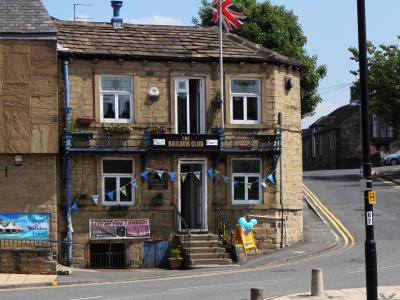
The Baildon Conservative Club building on Towngate is one of the few buildings to have survived the various works in Towngate. The other nearby buildings of any age are The Angel and Towngate Rooms. The buildings opposite were demolished leaving the older buildings of Westgate and the West side of Browgate.

In October 2020 it was reported that the club, which had closed due to the COVID-19 lockdown in March, had not re-opened and that the members had voted unanimously for it to be closed permanently. All club items were to be sold and the club secretary, Jean Barstow, said the building, valued at £335,000, was to be put up for sale.[16] Which raises a question -"Who owns the building?"
Noble’s Shop
This picturesque house and shop was situated at the Eastern side of the Towngate (between the Angel Hotel and Conservative Club.). Barclays Bank was built on the site of this building.[15]
The Ambler family owned and occupied it as a Butcher’s Shop and before Mr Noble a man called Riley Brook lived there. ( Grocer ) There is a record of the birth of Myrtilla Brook at the property in 1850, she had a brother ( Arnold ) who was blind. ( blind from birth )[15]
Mr W Noble occupied the property after Riley Brook and he purchased it in 1920 from the Ambler & Whitham Trust. The Nobles were Hardware Dealers and Willie Noble’s brother, Tom, had stables and a croft at the bottom of Westfield Terrace.[15]
In the early part of the twentieth century children used to go digging for lead bullets in the slag heaps near the rifle range on Baildon Moor and Mr Noble paid twopence a bucketful.[15] (See J W Noble for other anecdotes.)
In 1920, when the property was being auctioned Mr William Noble was still on Military Service, so his brother Tom bid at auction at the Angel Hotel. A year later when William Noble asked for transfer of the deeds to his name his brother demanded £100 profit. Willie had no choice in the matter but he never spoke to his brother again. The price paid at auctions was £665. The building was sold to Barclays Bank in 1967 and demolished.[15]
Barclay's Bank
This text is from the hand written notes of Arthur Edwick:-
The Bank appointed Mr Harry Robinson (Chemist) as its first agent for the village. Mr Robinson’s premises were Heather House, Browgate.[15]
Mr Richard Lancaster owned the three shops at the side of the Mechanics Institute in the Towngate. And at that time Barclay’s Bank was situated in a small office round the corner in Heather House, Browgate Pharmacy. [17]
At the suggestion of the manager, Mr Haley, the bank approached Mr Lancaster with an offer to purchase the three shops with the intention of demolishing the two shops in the centre of the block leaving the end shop intact. Mr Lancaster knew that the dividing walls of the shops & flats above were only single brick walls as one occupant, Mr Denby, had driven a six inch nail through and it had passed through the plasterwork of Mrs Jagger’s flat next door. Mr Lancaster sold the block of shops to the Bank with a clause in the agreement that if the rebuilding of the centre of the property proved structurally impossible and subsequently the end shop would have to be demolished the bank would compensate the occupant by rehousing them temporarily at the Bank’s expense and also find temporary shop accommodation, also at the Bank’s expense.[17]
The whole development proved financially disastrous for Barclays Bank. The whole block had to be demolished with subsequent compensatory payments etc. and all the delay involved in funding temporary accommodation for the occupant. Then work recommenced, but when excavation for the strong room started, the Baildon Moor Beck (which flows under the Towngate) was uncovered directly where it was hoped to construct the strong room. This led to much more delay.[17]
Eventually a very fine building was erected, but unfortunately Baildon Urban District Council decided to re-design the village centre and the fine edifice was demolished after only fourteen years. The Bank purchased Mrs Nobles shop & house on the eastern side of the Towngate. The property was demolished but unfortunately once again the excavation for the strong room was difficult to dig as the workmen “struck rock”, eventually dynamite had to be used.[17]
Mr Lancaster throughout these difficult days continued to use his a/c with the bank.[17]
The Noble's shop and house next to the Conservative Club were sold to Barclay's Bank in 1967.[18] This was to take the place of the building on Towngate next to the Mechanics Institute - all those buildings were to be demolished. Barclays occupied the first building for fourteen years which therefore dates the purchase/rebuilding of those buildings to 1953 or so.
Towngate House
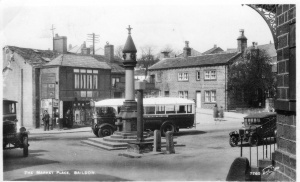
This building on Towngate was for many years owned by Baildon Urban District Council and it was used as the home for the Town Clerk, Mr Rudolph Howard Moore, who was appointed in 1920.
In 1935, when the drawing room of Towngate House was being prepared for redecorating, a fine example of a Tudor stone fireplace was found. The sixteenth century workmanship was similar to the fireplace in the Malt Shovel suggesting they could have been built at the same time and could even have been part of the same estate. In the nineteenth century an iron grate was fitted. It was decided to restore the fireplace and to make the rest of the room harmonise with this newly-discovered feature.[19]

In the 1960s a well was uncovered and then filled up in the garden of Towngate House.[20]
Towngate House was still the home of Mr Rudolph Howard Moore, the Clerk, up until the re-development of Towngate in the 1960s when it was demolished to allow better access for buses and to build new shops. Around that time the building was also reported to be structurally unsound.
Businesses
C G Lupton. -1929- Market Place, Ale & Porter Stores. High Class Grocer & Provision Merchant. Agent for Whiteway's Cider. Shipley 1028[14]
Photos
-
-
-
-
-
-
-
-
-
-
-
-
-
-
-
1969
-
-
Victory Celebrations 1945
-
Damaged pillar. 1923?
-
Replaced pillar. Damaged Cross. 1928
Combined Sewer Overflow
In March 2005 a large tank was sunk under the roundabout in the centre of Baildon to act as a Combined Sewer Overflow. The company responsible for the work have sent this PDF file for use on the Wiki. It shows the rounabout being worked on. This CSO overflows into Barnsley Beck.

Road Safety
Shipley Times and Express - Wednesday 10 October 1956
TRAFFIC DANGER IN BAILDON CENTRE
The danger from speeding traffic in Baildon centre was emphasised by several members of Baildon Council Highways and Buildings Committee at their meeting last Tuesday night.
The Clerk (Mr. R. Howard Moore) had caused some surprise when he told the Committee that their suggestion that traffic control signals should be installed at the Westgate, Browgate and Northgate Junction, Baildon, had not been adopted by the County Council Committee concerned.
Coun. Horace Chapman spoke of the dangers from traffic at this point. The real danger came from the driver who was not familiar with the district and came down the hill at an excessive speed, he said. What was wanted was a warning “Slow' or “Halt" sign put on the road from the moor.
While agreeing with the need for a halt sign, Coun. J. B. Franks said in his opinion the dangerous motorist was the one who did know the district and took the risks. The motorist not familiar with the area would usually slow down when he saw the bottle-neck road by the village fountain.
There was discussion, too, on the pedestrian crossing in the village, several members saying it was dangerous and that many drivers ignored it altogether.
Mr. R. Howard Moore said his Sunday mornings were made ghastly by a bunch of 18 to 20 motor cyclists who regularly roared at 40 m p.h. up Browgate and through the village.
Coun. Ambie Schofield said it was remarkable the number of motorists who ignored the pedestrian crossing at that point.
It was decided to refer the matter back the Road Safety Committee.
References
- ↑ Baildon and The Baildons. W Paley Baildon
- ↑ 2.0 2.1 2.2 2.3 2.4 The Story of Baildon The Stocks, Cross and Fountain
- ↑ Bradford Review Thursday 01 January 1863 Inauguration of a Drinking Fountain
- ↑ Shipley Times and Express Saturday 08 October 1927 A BAILDON LANDMARK
- ↑ Page 11 2002 Baildon Community Handbook
- ↑ Wikipedia Statute of Labourers 1351
- ↑ Baildon Local Board 14 Nov 1862 Notes
- ↑ 8.0 8.1 Bradford Antiquary 1888
- ↑ One Hundred Years Of Local History - section on W C Scruton
- ↑ The Bradford Daily Telegraph Saturday 11 June 1904 Day by Day
- ↑ Shipley Times and Express Friday 17 June 1904 The Old Village Stocks
- ↑ Shipley Times and Express 01 June 1923 Stocks
- ↑ Shipley Times and Express 31 August 1929 Stocks
- ↑ 14.0 14.1 1929 Baildon Hospital & Charities Week Programme
- ↑ 15.0 15.1 15.2 15.3 15.4 15.5 15.6 A Edwick handwritten notes. (Green folder)
- ↑ ExaminerLive 23 Oct 2020 Century-old Social Club Closed
- ↑ 17.0 17.1 17.2 17.3 17.4 Arthur Edwick handwritten notes. (Blue Folder)
- ↑ Invoice to Nobles from the Bank
- ↑ Shipley Times and Express - Saturday 22 June 1935 DISCOVERY OF TUDOR STONE FIRE PLACE
- ↑ Arthur Edwick handwritten notes.











